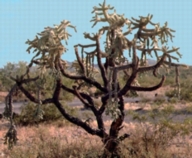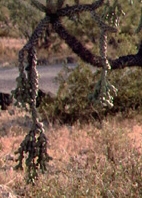

Common Names: Hanging
Chain Cholla, Jumping Cholla, Cholla Brincadora,
Vilas de Coyote
Genus: Opuntia
Species: fulgida

The chain fruit cholla looks as much like a tree in the desert as a cactus possibly can. It has a central trunk from which sprout many spiny "branches". It is commonly found in dry, sandy soils of bajadas, valleys floors, and plains of the Sonoran and Chihuahua Desert, south Arizona and northwest Mexico. It is found at elevations up to 4,000 feet above sea level.
The chain fruit cholla is a shrubby cactus. It has many segmented, irregular, drooping branches. These are covered with a dense layer of sharp spines. These spines have a straw-colored sheath when young which turns a dark gray as they mature. The sheath acts to reflect sunlight and prevent over heating. As the cholla gets older the spines fall off and leave a rough and scaly bark on the trunk and old branches. It is the largest of the cholla, and can grow to a height of 15 feet, and be 6 feet across.
The segmented branches have light-green leaves about 1/2 inch to 1 inch long when they are young. One inch long white and pink flowers streaked with lavender bloom from June to August. The flowers bloom at the end of the branches and on old fruit. The pear shaped fruit is about 1.5 inches long and half as wide. Clusters of these fruits sometimes stay attached for many years. New flowers will bloom on them every year and the chains grow longer with every year, sometimes as long as 2 feet. That is why they are called chain fruit cholla.

The chain fruit cholla is also called jumping cholla because the segments break off easily when brushed up against and stick to you, giving you the impression that the cactus jumped at you. They attach themselves to desert animals and are dispersed for short distances. The ground around a cholla is usually covered with segments that have fallen off the parent. The fruit is not always fertile and the cholla relies mainly on fallen stem joints and fruit to take root and grow new plants.
During droughts animals like the Bighorn Sheep rely on the juicy fruit for food and water. Large forests of chain fruit cholla grow in Arizona. The cactus is not considered to be vulnerable or endangered, mostly because they grow in inaccessible and hostile places of the desert.
2002
Bibliography:
"Chain Fruit Cholla (DesertUSA)", http://www.desertusa.com/mag98/may/papr/du_chaincholla.html, (9/7/02).
"Cylindropuntia fulgida", http://www.whitethornhouse.com/cacti/cacti01-09.htm, (9/7/02).
"Chain Fruit Cholla", http://www.dbg.org/Involved/chain_fruit_cholla.html, (9/7/02).